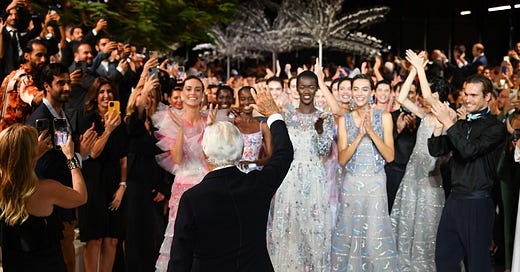
On Tuesday, Giorgio Armani announced that the brand will cancel its Men’s Spring and Couture shows this season. Both shows were supposed to happen in Milan in January. “This decision was made with great regret and following careful reflection in light of the worsening epidemiological situation,” a statement read. In 2020, Armani was one of the first brands to cancel its fashion show when the pandemic began, but still presented an audience free runway show. According to WWD, there won’t be a digital presentation this time around.
It’s a familiar situation, of course. Canceled shows were the norm in the early days of the pandemic, and almost everyone who decided to make a new collection either showed it digitally, or not at all. At that time, it appeared like there was an opportunity to make positive changes to the cycle of fashion. For InStyle in September 2020, I wrote an entire story about how brands could use the moment to push back against seasonality and finally recognize that there is no need for a new collection of clothing every few months. That didn’t happen.
By September 2021, fashion week was pretty much back in full swing. Big fashion shows were met with celebrity front rows, influencer’s nonstop Instagram stories and street style galleries. It all felt a little off given the fact that the pandemic was still a concern. Still, on it went without a hitch. For the last few months, it seemed like fashion had forgotten the dip in sales, the canceled orders that left garment workers without pay, the digital shows and the mood of change in favor of returning to the exact same pattern it's been in for decades. With the exception of some headlines about digital clothing entering the Metaverse, it’s all pretty much business as usual.
And then the Omicron variant came.
As far as retail sales are concerned, it's hard to say whether this will have a huge impact – it appears that inflation and supply chain issues may be the problems to watch if anything. From a seasonality perspective, though, round two of potentially superspreader fashion shows should be the catalyst these brands need to pull back. Instead of waiting until it’s too late, maybe, just maybe, we reassess the sheer amount of clothing that will be created in 2022. Even if the brands just pulled back on one season we could drastically reduce the amount of new clothing entering the market. Fast fashion may be the biggest culprit, but luxury brands contribute to these seasonal cycles as well. Why not expect better from them?
Here’s an idea: what if we had a repair season? Instead of putting out new clothing and hosting a lavish show, brands buy back old collections and use their already existing supply chain to repair them like new. Logistically, that might be difficult, but its been done before. Anything to stop this ever-spinning cycle, or at least slow it down as we head toward the February ready-to-wear season, would be a positive move.
What are your thoughts on this upcoming fashion calendar? Should we continue on as always?



